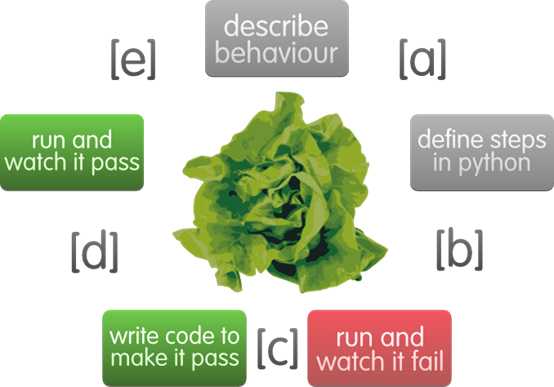python behave自动化测试框架(1)- 初探BDD,,一,什么是BDD
python behave自动化测试框架(1)- 初探BDD,,一,什么是BDD
一,什么是BDD
BDD全称Behavior Driven Development,译作"行为驱动开发",是基于TDD(Test Driven Development 测试驱动开发)的软件开发过程和方法。
BDD可以让项目成员(甚至是不懂编程的)使用自然语言来描述系统功能和场景,从而根据这些描述步骤进行系统自动化的测试。
二,常用BDD框架介绍
目前常用的BDD测试框架有Ruby中的Cucumber,Python中的Behave、Lettuce及Freshen等。
基本的流程如下图所示(Lettuce官方图):

简单来说就是"写用例->跑测试->看结果->写实现->看结果"这样的一个循环。
本教程选择behave来介绍PythonBDD自动化测试框架。
三,behave实例
1,behave安装
pip install behave # 全新安装pip install -U behave # 更新
2,Gherkin语法
上文提到的几种BDD框架均使用Gherkin语法,这是一种简单易懂的语言,使用关键字来定义系统特征和测试。
使用Gherkin语法编写的feature文件基本结构如下:
Title (one line describing the story/feature) As a [role] I want [feature] So that [benefit] Scenario: Title1 (for Behaviour 1) Given [context or setup] And [some more context]... When [event occurs] Then [expected outcome] And [another outcome]... Scenario: Title2 (for Behaviour 2) ...
并且Gherkin语法还支持中文
3,目录结构
Behave项目的目录格式如下:
$PROJECT/+-- features/ -- Contains all feature files.| +-- steps/| | +-- step_*.py -- Step definitions for features.| +-- environment.py -- Environment for global setup...| +-- tutorial*.feature -- Feature files.
下面简单说一下.feature和.py文件:
1) .feature文件是用于编写测试场,你可以把各种场景和数据写在里面,支持中文;
2) .py文件就是根据你写的测试场景和数据来执行测试。
3) 最好.feature文件与.py文件一一对应。
4,使用behave
描述功能
在工作目录新建文件夹features,在文件夹中新建adding.feature
Feature: Adding Scenario: Adding two numbers Given the input "2+2" When the calculator is run Then output should be "4"
Scenario: Adding two numbers Given the input "3+3" When the calculator is run Then output should be "6"
一个.feature文件里可以写多个Scenario,下面对这些关键词做一些简单的解析:
1) Feature:功能名称
2) Scenario:场景名称
3) Given:给出测试前提条件;
4) when:相当我们的测试步骤;
5) Then:给出期望结果
编写测试
然后在features目录下建立文件夹steps,在steps目录下新建adding_steps.py
from behave import given, when, then, step_matcher@given(u‘the input "{a:d}+{b:d}"‘)def step_given(context, a, b): context.a = a context.b = b@when(u‘the calculator is run‘)def step_when(context): pass@then(u‘output should be "{c:d}"‘)def step_then(context, c): assert context.a + context.b == c在features同级目录下cmd运行behave 即可
python behave自动化测试框架(1)- 初探BDD
评论关闭